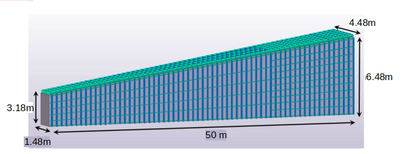SHiP


The Search for Hidden Particles (SHiP) experiment is an advanced research project proposed for a dedicated proton beam-dump facility at CERN's Super Proton Synchrotron (SPS). The SHiP experiment aims to detect feebly interacting particles, including right-handed Majorana neutrinos, axion-like particles, dark photons, and dark scalars. These particles, with masses ranging from a few hundred MeV to a few GeV, are predicted by several extensions of the Standard Model and are crucial for addressing key questions in elementary particle physics, such as the origin and smallness of neutrino masses, the matter-antimatter asymmetry of the universe, and the nature of dark matter.
Experimental Design
The experimental setup involves directing a 400 GeV proton beam into a heavy-metal target. This process results in proton-nuclei collisions, producing hadrons that are subsequently absorbed by an absorber. The charged muons generated are either stopped or deflected by a magnetized muon shield. The primary focus is on detecting feebly interacting particles, such as right-handed Majorana neutrinos, which are expected to have extended lifetimes. These particles travel through a 50-meter-long decay volume, where their decay products are then reconstructed by a series of sophisticated detectors.
Scientific Goals and Implications
The SHiP experiment is designed to provide significant insights into some of the most profound unsolved puzzles in particle physics. By investigating the properties and interactions of these elusive particles, SHiP aims to enhance our understanding of the mechanisms behind the smallness of neutrino masses, the matter-antimatter asymmetry in the universe, and the composition of dark matter.
For further details and updates on the SHiP experiment, please refer to our official publications and announcements.
Research Topics
-

Surround Background Tagger
To identify potential background events induced by muons and neutrinos, the decays volume is surrounded by surround background tagger, (SBT which is the detector we are working on. In the current design of the experiment, this detector is based on liquid scintillator with Wavelength-shifting Optical Modules (WOMs) coupled to SiPMs as photondetectors. We are working on the WOMs and SiPMs of this detector and study the capability to reduce the rejection of background induced by neutrinos and muons through the SBT detector.
Group members
-
Prof. Dr. Heiko Lacker
-
Postdoctoral research fellows
Christian Scharf
PhD students
Andrew Conaboy
Anupama Reghunath
Alessia Brignoli
Eduard Ursov
Publications & Links
